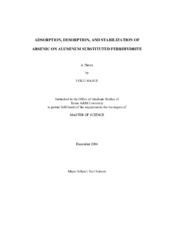| dc.description.abstract | Because of As toxicity, the complexity of its chemistry, and the recent lowering of the maximum contaminant level of As in municipal drinking water, there has been considerable interest for improved methods to remove As from water. Although Al and Fe hydroxides have been extensively studied as adsorbents for As removal during water treatment, coprecipitated Al:Fe hydroxides have received only minimal attention. The theoretical and experimental feasibility of coprecipitated Al:Fe hydroxide systems were evaluated by studying their mineralogy, stability, and As adsorption and desorption behavior.
The broad XRD peaks revealed that Al was substituted into the ferrihydrite structure and that this was the only major product up to about a 2:8 Al:Fe molar ratio. Gibbsite and bayerite were identified when Al content was higher. The rate of recrystallization of ferrihydrite into goethite and hematite was significantly reduced as Al substitution was increased.
In general, adsorption capacity of both AsV and AsIII decreased with increase in Al:Fe molar ratio; however, similar AsV adsorption capacities were observed with Fe and Al:Fe hydroxides with Al:(Al+Fe) molar ratios < 0.20. Both AsIII and AsV adsorption isotherms were effectively described by Langmuir and Freundlich equations. Adsorption maxima of AsV on Fe and Al:Fe hydroxides were observed at pH 3 to 7, and that of AsV on Al hydroxide was observed at pH 5.2, with significant decreases in adsorption with increase and decrease in pH. Adsorption maxima of AsIII decreased by approximately 4 % for each 10 % increase in Al substitution up to 5:5 Al:Fe molar ratio. Adsorption maxima of AsIII on Fe and Al:Fe hydroxides were observed at pH 8 to 9. AsIII adsorption on Al hydroxide was negligible. Counterion Ca2+, compared to Na+, enhanced the retention of AsV, especially at pH > 7. Counterion concentration did not significantly affect AsV adsorption. Though phosphate desorbed both AsV and AsIII from all Al:Fe hydroxides, quantitative desorption was never observed.
The results of this study indicate the possible utility of coprecipitated Al:Fe hydroxide in wastewater treatment. Based on adsorption/desorption behavior and stability of the Al:Fe hydroxide product, the preferred Al:Fe molar ratio was 2:8. | en |


